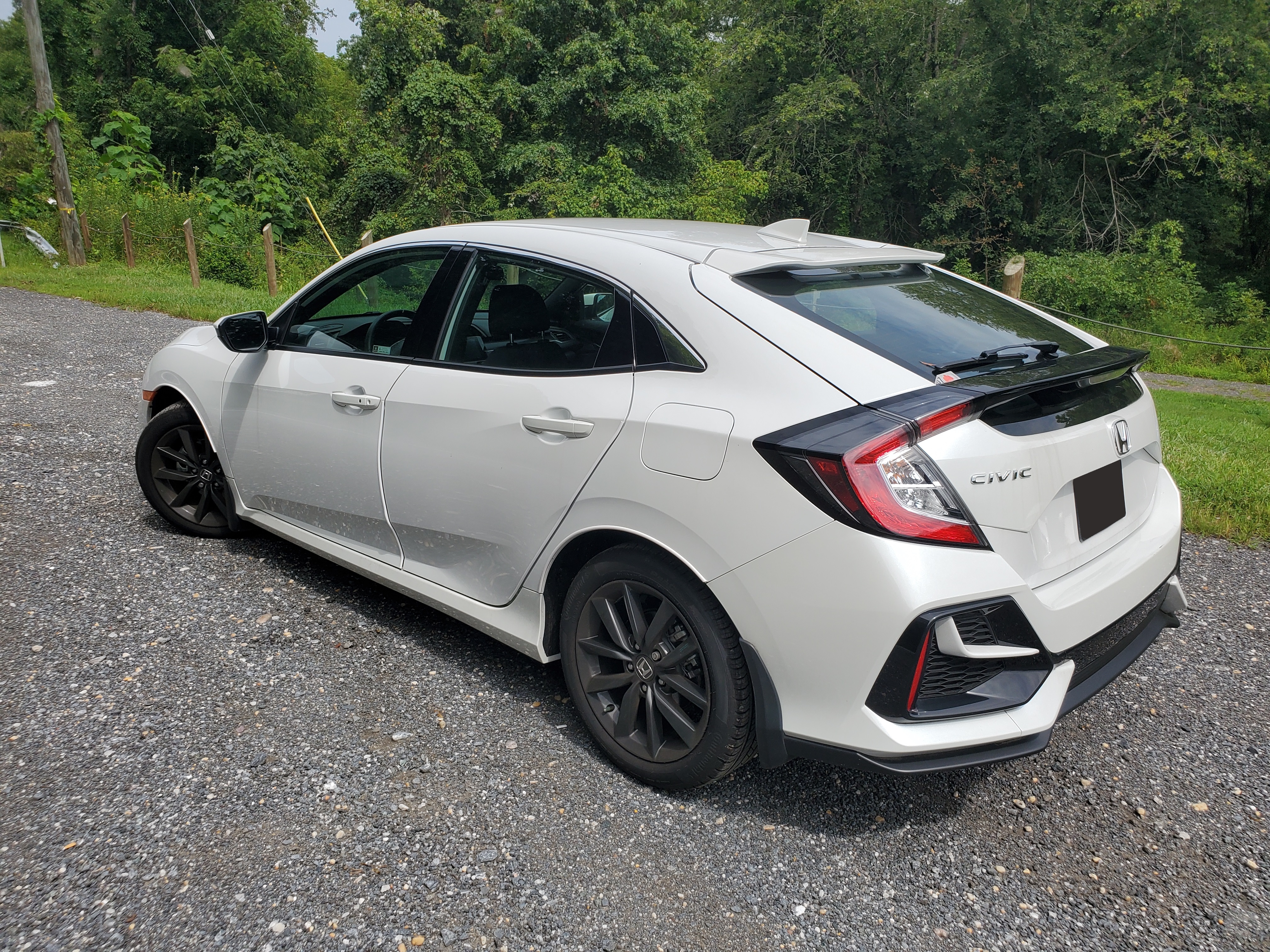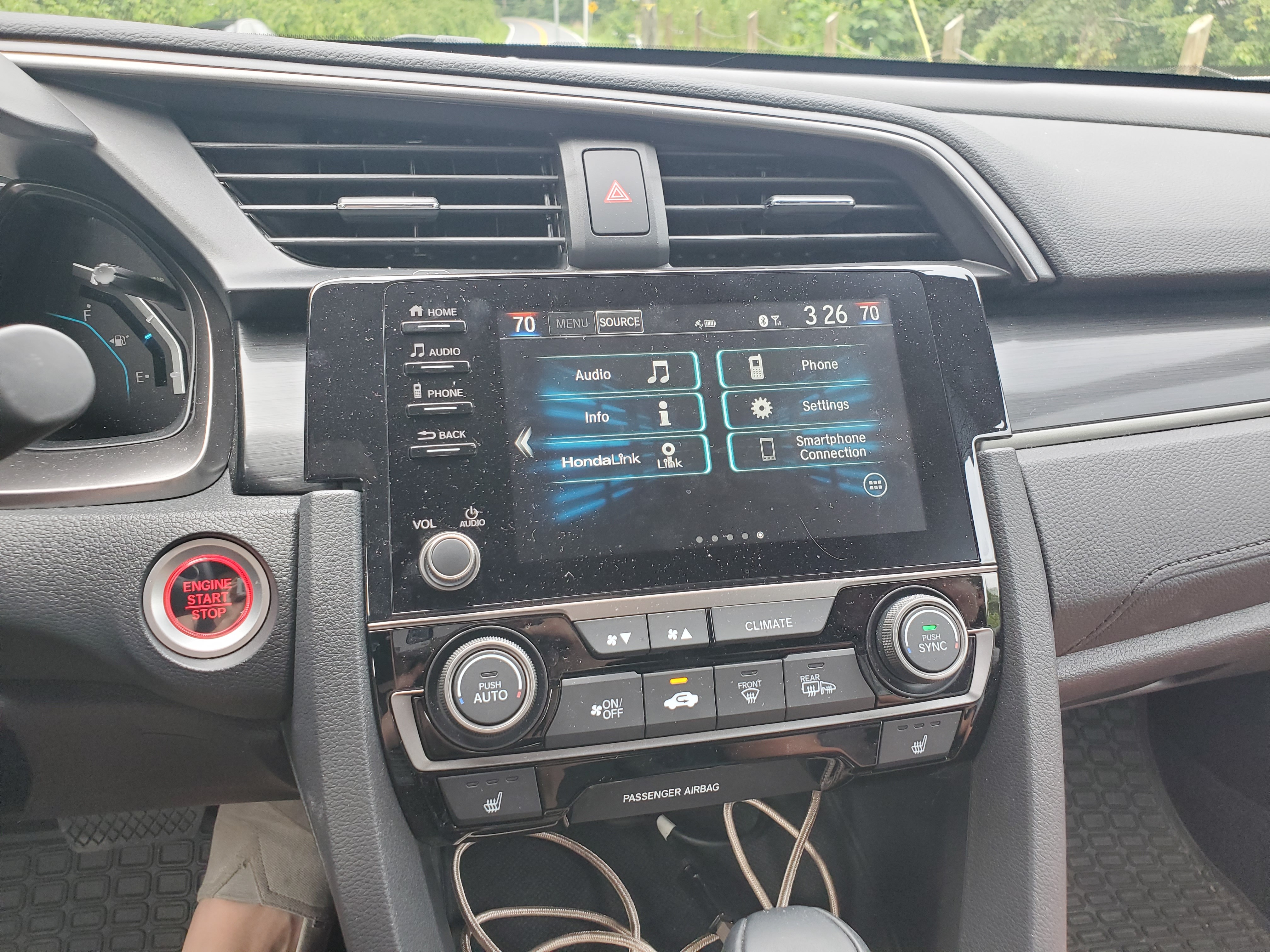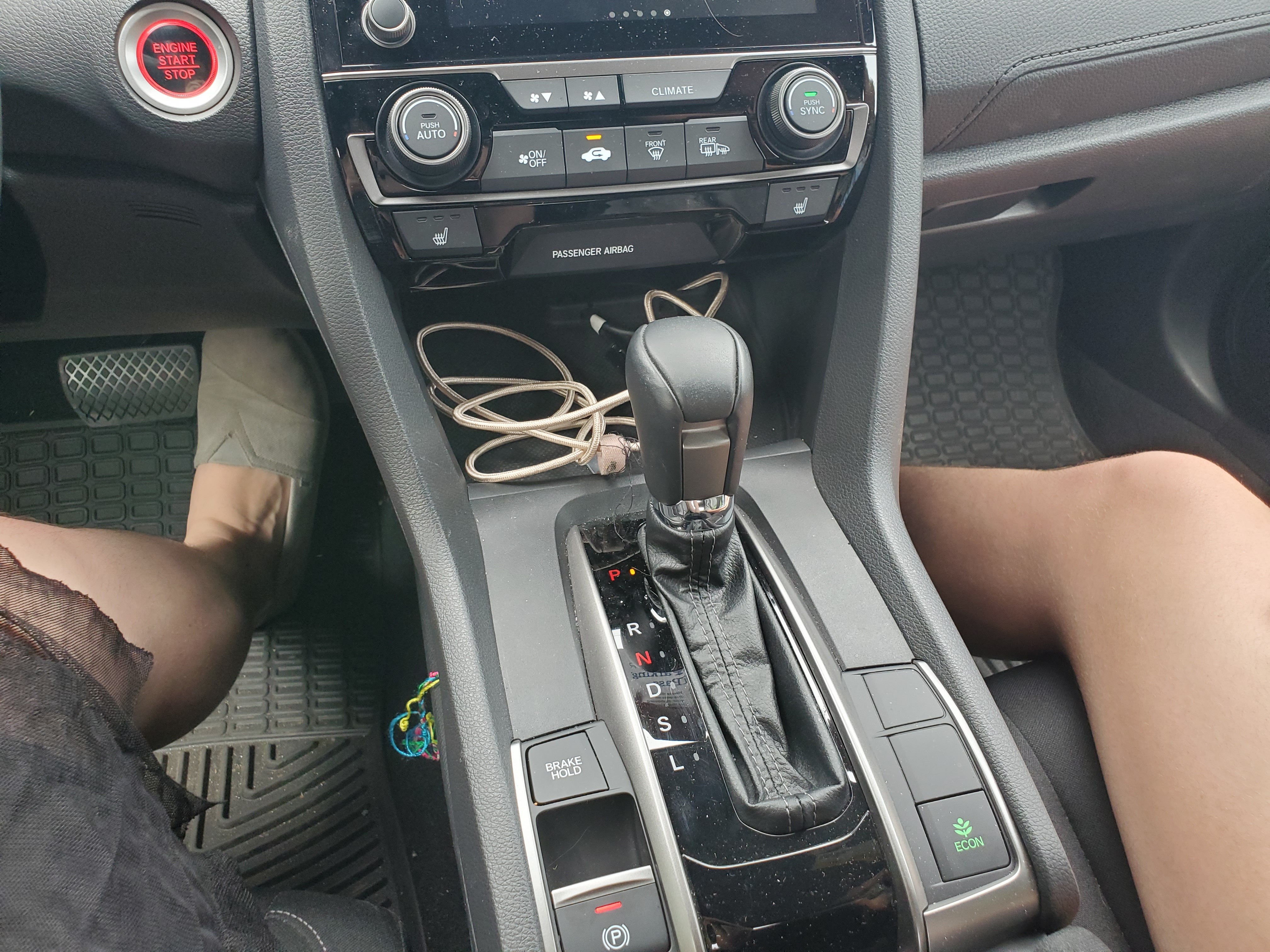
The tenth generation of the Honda Civic marked the return of the hatchback body style to the United States, after an absence of three generations, with the exception of the seventh generation Si. This surely caused quite a stir, given the enduring reputation of the 1990s Civic hatches as light, nimble, enthusiast-friendly machines. However, as any car enthusiast will tell you, car design has changed profoundly since the 1990s; gone are the one-airbag interiors, the standard manual gearboxes and station wagon bodystyles. Modern cars, by and large, are heavier, more powerful, and safer than the Civic hatches of yore. Has this change destroyed the potential for a modern interpretation, however? Or can the same spirit still be found through modern automotive design?
The most immediately striking aspect of the tenth gen Civic hatch is its silhouette. Gone are the days of boxy 3-door designs with steep rear windows; this is almost a fastback configuration, with a long, deeply sloped rear hatch whose length covers much of the rear trunk area. High rear quarter panels help exaggerate the athletic, tail-heavy design, and the roof slopes ever so slightly down from the front of the cabin towards the top of the hatch, resulting in a streamlined, teardrop-shaped passenger compartment. At the rear, a comically odd spoiler cuts across the back window, providing a place for the center stop lamp. What makes this so strange is that the hatch glass is in fact a single piece; to remove the glass, one also must remove the spoiler, a process made more complicated by what I suspect is a hole in the glass under the stop lamp for the electrical connections to pass through. It feels overdesigned, until you step back and look again; the end result is actually rather clever. The spoiler provides the same Kammback-like profile as some of Honda's most unique hatches, the CR-X, first gen Insight, and CR-Z, all of which have two-window rear hatches. In the 2021 Civic, the exact same visual result is achieved with half the pieces of glass and half the number of window seals that must be made weathertight. Perhaps the only downside is, combined with the car's second spoiler atop the rear window, a very aggressive, boy-racer sort of style is produced, which makes the car appear either youthful or pretentious depending on the critic.


Modern cars are not allowed to have much visual negative space, especially at the front and rear, and in that regard, the 2021 Civic's front end matches the rear quite well; huge fake vents, angular light fixtures, and plenty of glossy black plastic create an aggressive and busy front fascia that still maintains stylistic commonality with other models, particularly the Accord. In the big picture, the 2021 Civic hatch is in fact a very athletic, aggressive looking car, with spoilers and vents front and rear, as well as a low stance and streamlined body. This, however, comes at a cost. Repeat visitors to this blog will recall the Volkswagen CC, a meaner, more streamlined version of the Passat, whose interior space was greatly compromised by the aggressive, low roofline, despite the chassis' midsize dimensions. The same is true here. Though the cockpit up front is cozy and spacious enough, with the high point of the roof being approximately above the driver's head, rear headroom is compromised by the downwards slope, and despite the size of the car and the presence of a hatchback body plan, the deeply sloped hatch results in compromised cargo room. While the available cargo room is commensurate with something like the Elantra GT or Corolla hatch, this is achieved by the Civic hatch's greater length, particularly in rear overhang. Theoretically, Honda could have capitalized on the larger road footprint to maximize cargo capacity with a more wagon-like body style, raising the rear roofline and hatchback, this would have resulted in a heavier and less aggressive-looking car. Let's keep that design choice in mind.




The Civic hatch's interior is generally unobjectionable, economy car limitations notwithstanding. The seats are supportive, with effective bolsters, but aren't exactly comfortable; after a prolonged drive, one gets the same lower back tightness as the eighth generation Civic gave. The dashboard, the centerpiece of interior styling, is streamlined and modern, with bold, long lines and a limited pallette of colors and materials that provides a cool, modern appearance. The infotainment screen is lower in the dashboard, sitting where an older car stereo would be, rather than protruding up out of the dashboard like a piano black headstone. Visibility is decent up front and to the sides, but to the rear, Honda's athletic, deeply sloped hatch curses the driver with massive D pillars and a spoiler directly across their rear field of view, while the lane-keeping assist camera package blocks out a massive portion of the upper windshield. On the EX trim, which this is, the driver gets Honda's "Lanewatch" passenger-side camera, which only activates when the driver uses the right turn signal.
I feel compelled to digress slightly and discuss this camera, begging the reader's indulgence. Most cars these days have blind spot sensors available on some trim level, a reasonable quality-of-life add that is minimally intrusive to the way one typically changes lanes (mirror check, head check, then merge). This is a design decision that is about as logical as the NTSC television color encoding system, which was fully backwards-compatible with black-and-white sets. Similarly, blind spot warning is effectively backwards-compatible with how we are taught to drive. Honda's Lanewatch camera, simply put, is a new standard entirely. When you do you mirror check, you look at the mirror. Not the dashboard. Then you do your head check. The car's mirrors are effectively heads-up displays, not requiring the driver to dip their eyes below the car's beltline. To use Honda's Lanewatch camera, you have no choice but to break that style completely, looking at the dashboard below the beltline, as a replacement, rather than supplement, for...the mirror check? The head check? Both? I find this design decision captivatingly odd, to put it simply. The fact that the Lanewatch only works for merging to the passenger's side only makes it weirder. Why, Honda? Why did you have to reinvent an entire part of the driving experience?



One clever feature of the Civic's interior design is the amount of storage space available to the front row. Many modern cars, including this one, have begun blending the center console into the dashboard, integrating the console further into the infotainment stack, furthering the impression of a cockpit for the driver to be ensconced in, rather than a discrete vertical dashboard and center console. In the 2012 Ford Focus, this blending of surfaces greatly compromised the amount of storage available to the driver, making the center console into a big monolithic block of plastic. Honda escaped this plight with a pair of vertically stacked storage bins in front of the shifter, connected by a small passage for phone charging cables, as well as a cavernous armrest bin with movable cupholders for even more options. To put it simply, the Civic's interior achieves a modern design, with the touches the car buyer of today expects, without compromising utility (too much).
The infotainment stack is of acceptable quality, with a reasonably easy to use interface, but in their drive to simplify the console's layout, Honda has placed some of the HVAC controls in the screen's menus, rather than on the HVAC panel. The instrument panel also attempts to simplify the interior, discarding the typical two-dial design in favor of a single central screen for all the driver's data except the fuel and temperature levels. The center screen, which places a digital speedometer inside an entirely simulated tachometer dial, provides the typical variety of multifunction display functions, with a notable exception being the boost pressure gauge. While the driver can't get the exact pressure in psi, they can at least get some idea of the turbo's load level, a feature that, in turbocharged cars, may actually be more useful than a tachometer, especially in a car like this that lacks a manual mode. The steering wheel is nothing special, but the buttons are easy to navigate, and its rim is not so highly contoured that it becomes difficult to use. In a general sense, the dashboard is very efficient in terms of information throughput, with heavy reliance on multifunction screens, a modern design philosophy indeed. Let's just hope those displays can last for the life of the vehicle.
The car's noise, vibration, and harshness are commensurately as modern as the interior design. The cabin is quiet and comfortable, and despite a road-hugging suspension tune, bumps and potholes get soaked up by the suspension, only starting to lose their composure on exceptionally rough roads, though road surface feel is somewhat numbed by the electric power steering. This, however, is probably a net good for the average user. The Civic exhibits remarkable grip in most driving conditions, aided by 17 inch wheels wrapped in 215 millimeter wide tires. The car turns in eagerly to corners with direct-feeling steering, and clings tenaciously to the pavement unless the driver starts to get very demanding indeed, a state of affairs likely aided by Honda's switch from the ninth generation Civic's double-wishbone rear suspension system to a control blade-style multilink system. Outside of the corners, the steering manages to feel responsive without being too heavy, and combined with strong NVH mitigation and the aforementioned well-tuned suspension, everything but the dubiously comfortable seats feels roadtrip-ready. The Civic hatch weighs just short of 3000 pounds, meaning it isn't exactly light for a compact car, but despite this, it feels fairly light and responsive.


The EX trim of the Civic hatch is only available with a continuously variable transmission, coupled to a 1.5L turbocharged four cylinder that makes about 170 horsepower and 160 lb-ft of torque. While these aren't pavement-searing numbers, they make the car feel energetic and eager, and thanks to Honda's boost tuning, the tiny four cylinder has impressive torque across much of the rev range. Perhaps the only letdown with this charming little turbo four is the noise; below about 4000 rpm, it's as quiet as a sewing machine, and above 4000 rpm, it only just barely starts to growl. Perhaps a frighteningly cheap aftermarket exhaust from eBay could improve matters.
Helping the 1.5L motor hustle the Civic along is the aforementioned continuously variable transmission, controlled by an easy to grab shifter with firm, communicative detents. Honda has done a bang-up job programming this unit; it never pretends to shift like an automatic, instead picking an engine speed commensurate with throttle position, and will gleefully pin the engine near to redline if the driver floors it. The CVT's ratio-picking also results in a quiet cabin, smooth acceleration, and decent enough fuel economy, rated by the EPA at 34 mpg combined. Most CVTs these days come either with a manual mode or a "sport" mode, but the implementation of these varies widely between manufacturers. For many manufacturers, sport mode ends up prioritizing engine braking far more than responsive power delivery, but Honda seems to have achieved the best of both worlds. Despite the presence of a CVT and the absence of the ability to pick one's own gears, the Civic hatchback is an enthusiastic, fun little car. It's a true shame that not every continuously variable transmission can be as responsive, fun, and effective as this one.


In short, the Civic hatchback is a comfortable, fun to drive family car that is neither so practical as to seem dowdy, nor so aggressively enthusiast-oriented that it becomes hostile to the average buyer, a true middle ground. While the hatchback body style, commuter-friendly electronics, and comfortable ride make it a sensible daily driver, Honda has been careful to not allow it to seem too sensible: The boy-racer styling, the low roof, the default engine being the higher option from the sedan (no 2.0L naturally aspirated motor for the hatch), these things surely compromise the family economy car image...but that's the point. The Civic hatch is careful to deliver a "best of both worlds" user experience, though that compromises both extremes. The dashboard design, styling touches, and mechanical engineering all indicate great attention to detail, great care being placed in the production of a product that stands out from the typical economy car model. Is that all there is to this car, though? After all, the Civic has historically been a very versatile car, its economy, practicality, and sporting capabilities allowing it to be many different things for many different people.
I often say that a person's reading of a car depends just as much on them as it does on the car. However, I wonder whether that is something that Honda deliberately engineered out of this car. To me, it feels as though Honda has poured every bit of their auto-building muscle behind making this car read as one thing and one thing only: A comfortable-practical-sporty-stylish-not-your-mama's-civic compact car for the modern era. It feels as though so much effort has been given to finding the perfect middle ground between "car as appliance for moving things and people" and "car as emotional text/fashion statement/object of personal pride and identity", that it is impossible to read anything else from it. For perhaps the loosest metaphor that has yet been deployed on this blog, I am reminded of Bong Joon Ho's Snowpiercer, a captivatingly bleak post-apocalyptic film concerning the last dregs of humanity holed up in a giant, unstoppable train. That film's very premise, the core of its very story, is inseparable from the narrative of class warfare, of inequality and the moral mandate of revolution, to the point that I seriously doubt that another reading is possible. This car feels the same way. There is one way to read this text, and that is by design.
Popular media loves a reboot; just look at all the film and television adaptations of earlier books and movies. It allows the producers of such works to capitalize on pre-existing interest, nostalgia, on a pre-existing context for the text and the people who interact with it, and deliver something novel, something (sometimes) more in tune with the modern day and age. I think that's what this car is, in a way. Honda has taken their legacy of small, efficient, quirky, fun hatchbacks, and repackaged that meta-narrative into a new product. In an objective sense, is this car particularly small, efficient, quirky, or fun? Not exceptionally so. But the combination of those factors, to the admittedly impressive degree that this car is able to achieve, results in a car that is a reboot of the CRX or the Civic hatches, in a certain sort of way. Not because it is just as small or efficient or cheap or nimble as they were, but because it says it is. This is a car whose narrative is that it is good enough. This is a car that doesn't reassure you of your performance as a driver, it reassures you of its own performance. Be reassured that the Civic hatch is like a reboot of the old one. Be reassured that Hondas are still fun little cars, because their cars talk the talk. Be reassured that you're part of that automotive legacy, the dynasty of four-cylinder hatchbacks that has dominated car meets for the last 20 years. What makes a worthy successor? To be a duplicate, a clone? Or to continue the narrative, to keep telling the same story? Does a successor merely do, or does a successor tell? Car enthusiasts love to debate the nature of "remake" cars like the new Bronco, the upcoming Hummer EV or Integra, the fifth generation Supra; any of these models seemingly begs for the scrutinization of its nature, of its technical background and driving behaviors, leading to things like people saying the new Supra isn't a Supra because it's built around the BMW Z4's chassis, or because it lacks a manual gearbox, and this scrutinization, truth be told, seems to threaten to eclipse any discussion of these cars on their own. As with many problems with the automotive discourse, it is the view of the author, and this blog, that this is the result of a tendency to over-prioritize technical parameters in the discussion of cars, treating them as dumb machines even as one's emotional responses are driven by a deep emotional attachment to the messages and symbols that cars communicate. Taking a textual view of the concept of a "remake" car, we can draw the same conclusion as we have drawn of many other cars reviewed here: The emotional impression, the messaging that a car imparts, ultimately does far more to influence the thoughts, the beliefs, the experiences of its driver, than its technical parameters do. This indicates that the primary duty of a remake car, its first and foremost textual responsibility, is not to communicate the same message as the original did. Instead, the remake should simply communicate that it in fact is a worthy successor. It has no other responsibility; to try to emulate, to the letter, the original, is to make a car that is out of touch with modern automotive design. The 2021 Civic hatch is a remake car that has succeeded at this, with flying colors. It is a successful remake car, as it has fulfilled every textual responsibility it had to its predecessors the CRX, the 1st gen Insight, the CRZ. The question remains, however: Is that good? The answer to that question is more crucial than anything in the judgment of this car, and ultimately, it rests in your hands, not mine. It's up to you. This car is only what you allow it to be.